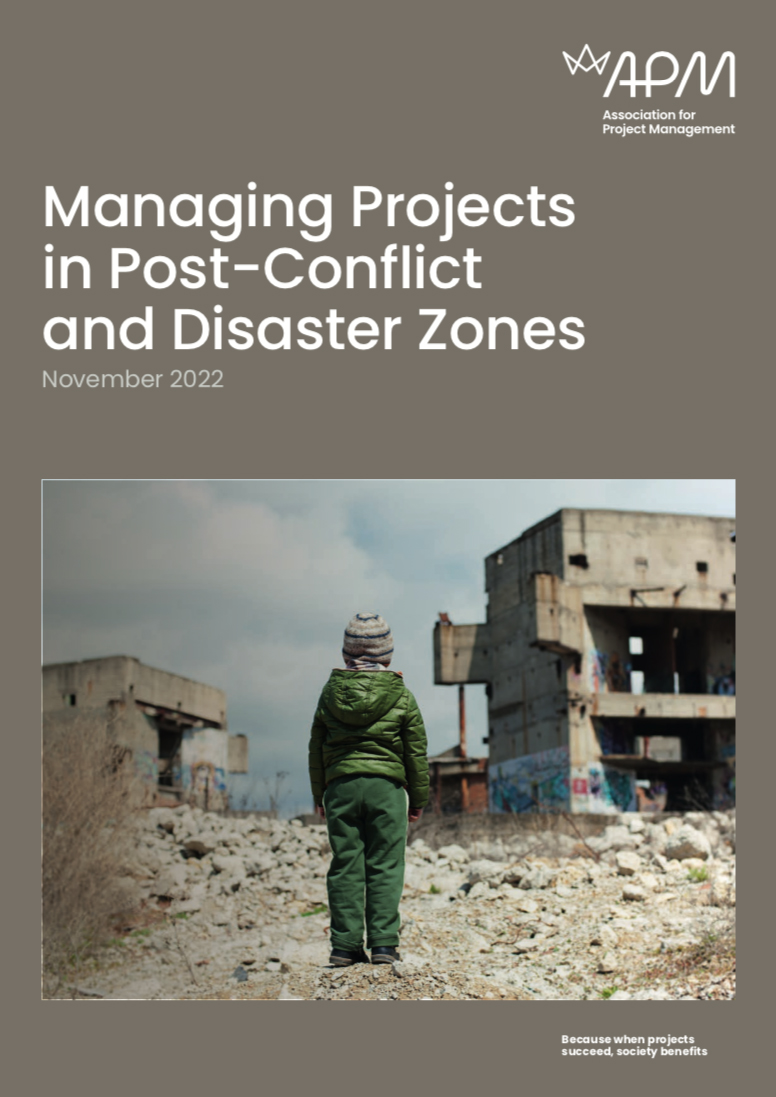Managing projects in post-conflict and disaster zones APM
New APM report reveals how project managers can deliver in extreme environments.
Contents |
[edit] A Volatile, Uncertain, Complex and Ambiguous world
The war in Ukraine has highlighted an uncomfortable truth. Our world is becoming increasingly Volatile, Uncertain, Complex and Ambiguous (VUCA). Events that are described as ‘once in a lifetime’ or ‘once a generation’ are becoming regular occurrences. In the past three years alone, we have seen a global pandemic, an energy crisis, record-breaking temperatures and now an economic crisis. It’s rapidly becoming more important than ever that project and programme managers adopt an awareness of the skills needed to deliver projects in uncertain times.
By drawing on the insights of those who have operated in some of the most challenging environments on the planet, Association for Project Management (APM) has published a new report, Managing Projects in Post-Conflict and Disaster Zones, which shares the key learnings from their experiences of delivering projects.
[edit] Recognising the specific skillset
Project management in extreme environments requires a specific skillset, but what does this look like? And what does it take to be effective in this arena? Managing Projects in Post-Conflict and Disaster Zones shares insights from professionals working in the military and humanitarian non-governmental organisations on bringing structure to chaotic situations through good project management.
While there is no doubt that good projects have always been adaptive and responsive, our changing and challenging world means this has become even more critical. This means many insights from the report can also be applied to ‘regular’ project management.
James Simons, APM’s Content Publishing Manager, said: “While the catalyst for this paper has been the war in Ukraine, the fact that we live in turbulent times means that project professionals must be adaptive and ready to pivot when called on to do so. Delivering projects in extreme circumstances is becoming increasingly commonplace, even in the UK. We therefore encourage all project professionals to take-away the learnings from this report; many of which can be applied to any type of project.”
[edit] Learnings from those who are used to dealing with extreme situations
[edit] When things get unclear, reaffirm your project’s purpose
The more uncertain the environment, the greater the focus should be on the overall impact rather than very specific results and outcomes.
Contributor, Lt Col Langley Sharp ran The Centre for Army Leadership and is author of Habit of Excellence: Why British Army Leadership Works. He explained: “You have to define the purpose of the mission and communicate it to everyone.
“If the purpose is clear, it galvanises everyone together… whenever things are seemingly so overwhelming, so complex, and so unachievable that fractures occur in your team, you must focus back on: what is your aim? What is the purpose of being here - the mission? That focus of mind allows you then to prioritise what work needs to be done and when it needs to be done.”
[edit] Use an agile approach if things are changing quickly
An agile approach is favoured for most emergency situations, especially in the initial response as it allows for any change as more information becomes available. The greater the element of emergency, then the argument grows for working in a more agile way.
It’s important to decide what the right method is for your project. For example, a sequential approach – with linear phases – may be appropriate for slow-burn development work in a relatively stable environment. But in emergency situations a more agile approach is required. Whatever the approach, the plan must be well communicated and understood.
Lt Col Langley Sharp strongly supports a flexible and adaptive approach to cope with today’s changing requirements, he commented: “With the complexity of the world today, linear plans are almost non-existent.”
[edit] Fully engage with stakeholders to support project success
Project managers must always engage with key stakeholders directly impacted by the project. This ensures everyone affected understands the goals and will be more likely to be on board.
Dan Connors, an ex-military intelligence officer who is Co-founder of Applied Influence Group, says that “influence mapping is a useful tool that can capture all the key stakeholders, their relationships, and what is driving them in terms of motivations. Nevertheless, the objective of stakeholder management is not just to understand what people want; it’s also to gain their trust and credibility so that you can achieve what you have set out as your objectives”.
[edit] Remember, all projects are delivered by people:
- All project managers should have compassion, whether it’s a humanitarian situation or a high-stress situation, leaders have a duty of care.
- It’s important to understand the individual strengths and vulnerabilities to maximise the ability of the team.
- Encouraging people to talk about issues and providing a safe space to decompress can be effective ways to support their well-being.
You can read the full report here.
This article appeared as "New APM report reveals how project managers can deliver in extreme environments" on the APM News and Blog site dated December 1, 2022.
--Association for Project Management
[edit] Related articles on Designing Buildings
- APM articles.
- After Mexico - earthquakes and resilient cities.
- Avoiding disaster in existing buildings and infrastructure.
- Climate change.
- Disaster.
- Earthquake Design Practice for Buildings.
- Earthquake resistant building materials.
- Earthquakes and the seismic strengthening of churches.
- Flood.
- Future proofing construction.
- Helping communities recover from disasters and protecting them before they occur.
- How to rebuild using the debris from disasters.
- Hurricane design considerations.
- Project manager.
- Managing and Responding to Disaster.
- Natural disaster.
- Research and development in disaster response.
- Sendai Framework for Disaster Risk Reduction.
- Summerland disaster.
- Ten years on – Lessons from the Flood on building resilience.
- Tropical cylcone.
- Tsunami.
Featured articles and news
Delivering for tenants; National Retrofit Hub
New report offers recommendations to strengthen energy efficiency standards to protect private renters.
Government consultations for the summer of 2025
A year of Labour, past and present consultations on the environment, the built environment, training and tax.
CMA competitiveness probe of major housing developers
100 million affordable housing contributions committed with further consultation published.
Homes England supports Greencore Homes
42 new build affordable sustainable homes in Oxfordshire.
Zero carbon social housing: unlocking brownfield potential
Seven ZEDpod strategies for brownfield housing success.
CIOB report; a blueprint for SDGs and the built environment
Pairing the Sustainable Development Goals with projects.
Types, tests, standards and fires relating to external cladding
Brief descriptions with an extensive list of fires for review.
Latest Build UK Building Safety Regime explainer published
Key elements in one short, now updated document.
UKGBC launch the UK Climate Resilience Roadmap
First guidance of its kind on direct climate impacts for the built environment and how it can adapt.
CLC Health, Safety and Wellbeing Strategy 2025
Launched by the Minister for Industry to look at fatalities on site, improving mental health and other issues.
One of the most impressive Victorian architects. Book review.
Common Assessment Standard now with building safety
New CAS update now includes mandatory building safety questions.
RTPI leader to become new CIOB Chief Executive Officer
Dr Victoria Hills MRTPI, FICE to take over after Caroline Gumble’s departure.
Social and affordable housing, a long term plan for delivery
The “Delivering a Decade of Renewal for Social and Affordable Housing” strategy sets out future path.
A change to adoptive architecture
Effects of global weather warming on architectural detailing, material choice and human interaction.
The proposed publicly owned and backed subsidiary of Homes England, to facilitate new homes.
How big is the problem and what can we do to mitigate the effects?
Overheating guidance and tools for building designers
A number of cool guides to help with the heat.
The UK's Modern Industrial Strategy: A 10 year plan
Previous consultation criticism, current key elements and general support with some persisting reservations.
Building Safety Regulator reforms
New roles, new staff and a new fast track service pave the way for a single construction regulator.



























